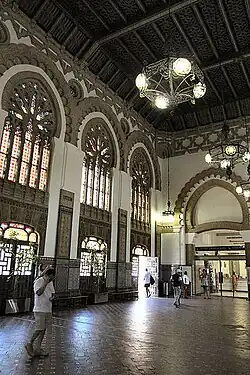Narciso Clavería y de Palacios
Narciso Clavería y de Palacios, 3rd Count of Manila (1869–1935) was a Spanish architect, notable as an exponent of the Moorish revival style known as Neo-Mudéjar. He was the grandson of Narciso Clavería y Zaldúa, a nineteenth-century Governor General of the Philippines from whom he inherited the title of Count of Manila.

Railway architecture
Working for the railway company Compañía de los Ferrocarriles de Madrid a Zaragoza y Alicante (MZA), Clavería designed Toledo railway station, his best-known building. Clavería incorporated references to Toledo's architectural heritage, which he had spent some time photographing.[1] The facility features a spacious hall with Moorish revival decoration and a clock-tower.
The smaller station at Algodor, between Toledo and Aranjuez, is also attributed to Clavería.[2]
Amateur photographer
He also cultivated photography as an amateur. In color he made more than 700 autochrome Lumière plates between 1909 and 1926. He was a member of the Royal Photographic Society of Madrid, where he projected his transparencies on glass. In autochrome images his favorite subjects were views of the city of Toledo,[3] Madrid gardens, still lifes and family portraits. In black and white he obtained thousands of plates on his summer trips. For example in Asturias in 1899.
References
- ^ Clavería's photographs were published in the Revista Toledo. ("Toledo a comienzos". Retrieved June 9, 2012.)
- ^ "Historia: Algodor". RTA (Red de transportes de Aranjuez) (in Spanish). Retrieved 2018-10-26.
- ^ "Placas autocromas de Toledo. Vistas de Narciso Clavería y Auguste Léon". Archivo Secreto, nº 8, 2025, pp. 386-427.